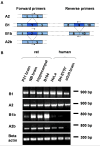Differential subcellular distributions and trafficking functions of hnRNP A2/B1 spliceoforms
- PMID: 20406423
- PMCID: PMC2906249
- DOI: 10.1111/j.1600-0854.2010.01072.x
Differential subcellular distributions and trafficking functions of hnRNP A2/B1 spliceoforms
Abstract
Trafficking of mRNA molecules from the nucleus to distal processes in neural cells is mediated by heterogeneous nuclear ribonucleoprotein (hnRNP) A2/B1 trans-acting factors. Although hnRNP A2/B1 is alternatively spliced to generate four isoforms, most functional studies have not distinguished between these isoforms. Here, we show, using isoform-specific antibodies and isoform-specific green fluorescent protein (GFP)-fusion expression constructs, that A2b is the predominant cytoplasmic isoform in neural cells, suggesting that it may play a key role in mRNA trafficking. The differential subcellular distribution patterns of the individual isoforms are determined by the presence or absence of alternative exons that also affect their dynamic behavior in different cellular compartments, as measured by fluorescence correlation spectroscopy. Expression of A2b is also differentially regulated with age, species and cellular development. Furthermore, coinjection of isoform-specific antibodies and labeled RNA into live oligodendrocytes shows that the assembly of RNA granules is impaired by blockade of A2b function. These findings suggest that neural cells modulate mRNA trafficking by regulating alternative splicing of hnRNP A2/B1 and controlling expression levels of A2b, which may be the predominant mediator of cytoplasmic-trafficking functions. These findings highlight the importance of considering isoform-specific functions for alternatively spliced proteins.
Figures











Similar articles
-
Intracellular trafficking of hnRNP A2 in oligodendrocytes.Exp Cell Res. 2002 Oct 1;279(2):310-20. doi: 10.1006/excr.2002.5604. Exp Cell Res. 2002. PMID: 12243756
-
Heterogeneous nuclear ribonucleoprotein A3, a novel RNA trafficking response element-binding protein.J Biol Chem. 2002 May 17;277(20):18010-20. doi: 10.1074/jbc.M200050200. Epub 2002 Mar 8. J Biol Chem. 2002. PMID: 11886857
-
Heterogeneous nuclear ribonucleoprotein (hnRNP) E1 binds to hnRNP A2 and inhibits translation of A2 response element mRNAs.Mol Biol Cell. 2006 Aug;17(8):3521-33. doi: 10.1091/mbc.e05-10-0946. Epub 2006 Jun 14. Mol Biol Cell. 2006. PMID: 16775011 Free PMC article.
-
RNA trafficking in oligodendrocytes.Results Probl Cell Differ. 2001;34:69-81. doi: 10.1007/978-3-540-40025-7_5. Results Probl Cell Differ. 2001. PMID: 11288680 Review.
-
Systems analysis of RNA trafficking in neural cells.Biol Cell. 2005 Jan;97(1):51-62. doi: 10.1042/BC20040083. Biol Cell. 2005. PMID: 15601257 Review.
Cited by
-
Molecular pathways involved in pregnancy-induced prevention against breast cancer.Front Endocrinol (Lausanne). 2014 Dec 10;5:213. doi: 10.3389/fendo.2014.00213. eCollection 2014. Front Endocrinol (Lausanne). 2014. PMID: 25540638 Free PMC article. Review.
-
Oligodendroglial Argonaute protein Ago2 associates with molecules of the Mbp mRNA localization machinery and is a downstream target of Fyn kinase.Front Cell Neurosci. 2015 Aug 25;9:328. doi: 10.3389/fncel.2015.00328. eCollection 2015. Front Cell Neurosci. 2015. PMID: 26379499 Free PMC article.
-
Multivalent Molecules as Modulators of RNA Granule Size and Composition.Biophys J. 2017 Jul 25;113(2):235-245. doi: 10.1016/j.bpj.2017.01.031. Epub 2017 Feb 24. Biophys J. 2017. PMID: 28242011 Free PMC article.
-
Functional implications of the emergence of alternative splicing in hnRNP A/B transcripts.RNA. 2010 Sep;16(9):1760-8. doi: 10.1261/rna.2142810. Epub 2010 Jul 22. RNA. 2010. PMID: 20651029 Free PMC article.
-
Intracellular Protein Shuttling: A Mechanism Relevant for Myelin Repair in Multiple Sclerosis?Int J Mol Sci. 2015 Jul 3;16(7):15057-85. doi: 10.3390/ijms160715057. Int J Mol Sci. 2015. PMID: 26151843 Free PMC article. Review.
References
-
- Sossin WS, DesGroseillers L. Intracellular trafficking of RNA in neurons. Traffic. 2006;7(12):1581–1589. - PubMed
Publication types
MeSH terms
Substances
Grants and funding
LinkOut - more resources
Full Text Sources
Molecular Biology Databases

